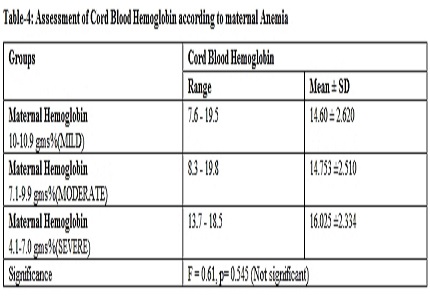Effects of maternal hemoglobin on fetal birth weight
Abstract
Introduction: Anaemia is one of the main nutritional deficiency disorders affecting a large proportion of the population, not only in developing but also in industrialized countries. The high prevalence of iron and other micronutrient deficiencies among women before and during pregnancy in developing countries is of concern and maternal anaemia is still a cause of considerable perinatal mortality and morbidity. The improvement in the industrialized world is due largely to more effective diagnosis and treatment of anaemia.
Aim of the study: To determine effect of maternal hemoglobin on fetal cord blood haemoglobin and birth weight, To find out relation between cord blood haemoglobin and maternal haemoglobin & to find the relation of birth weight to maternal haemoglobin.
Results: The prevalence of low birth weight among anemic mothers was 24%. Total number of babies with cord blood hemoglobin < 16.8 gms % in mild anemic mothers were 74 (80.4%) moderate anemia were 43(79.6%) and in severely anemic mothers were 2 (50%). The demographic data of patients were studied for the 3 groups (mild, moderate, severe according to WHO classification of anemia) The means of the continuous variables were compared between the two groups using analysis of variance ANOVA. The P value of < 0.05 was considered statistically significant.
Conclusion: In babies born to anemic mothers cord blood hemoglobin is low. Severity of maternal anemia is determinant of low birth weight. The proportion of low birth weight in babies born to severe anemic mothers were more when compared to mild and moderate anemia
Downloads
References
2. Gruenwald P: fetal l Growth and Development, Williams Obstetrics, 23e > Chapter 43.
3. Chandra S, Anil Kumar T Anemia: A Brief Overview Regards the Pregnant State. J Womens Health, Issues Care, 2014; 3:1.
4. Ballard JL, Khoury JC, Wedig K, Wang L, Eilers-Walsman BL, Lipp R. New Ballard Score, expanded to include extremely premature infants. J Pediatr. 1991 Sep; 119(3):417-23.
5. Sumithra Muthayya ,Maternal nutrition & low birth weight - what is really important?Division of Nutrition, St. John’s Medical College & Research Institute, St. John’s National Academy of HealthSciences, Bangalore, India. Indian J Med Res 130, November 2009, pp 600-608.
6. R.G. Viveki,A.B. Halappanavar,P.R. Vivek,S.B. Halki,V.S. Maled, P.S. Deshpande ,Prevalence of Anaemia and Its Epidemiological Determinants in Pregnant Women2012, AJMS US National Library of Medicine enlisted journal).
7. Levy A, Fraser D, Katz M, Mazor M, Sheiner E.,Maternal anemia during pregnancy is an independent risk factorfor low birthweight and preterm delivery.2005;122(2):182–186.International Journal of Gynaecology & Obstetrics. [PubMed]
8. Malhotra M, Sharma JB, Batra S, Sharma S, Murthy NS, Arora R. Maternal and perinatal outcome in varying degrees of anemia. Int J Gynaecol Obstet. 2002 Nov;79(2):93-100. [PubMed]
9. Bondevik GT, Lie RT, Ulstein M, Kvåle G. Maternal hematological status and risk of low birth weight and preterm delivery in Nepal. Acta Obstet Gynecol Scand. 2001 May;80(5):402-8. [PubMed]
10. Dr. NadiaMudher Al-Hilli,The Effect of Maternal Anaemia on Cord Blood Haemoglobin& Newborn Birth Weight,2010,Karbala Journal of Medicine, 2(8-9), 2010.
11. Singla PN, Tyagi M, Kumar A, Dash D, Shankar R. Fetal growth in maternal anaemia. J Trop Pediatr. 1997 Apr; 43(2):89-92. [PubMed]

Copyright (c) 2016 Author (s). Published by Siddharth Health Research and Social Welfare Society

This work is licensed under a Creative Commons Attribution 4.0 International License.


 OAI - Open Archives Initiative
OAI - Open Archives Initiative


